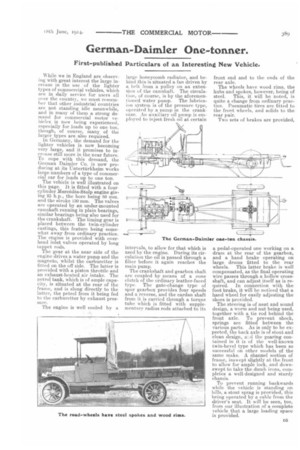German.Daimler One-tonner.
Page 19

If you've noticed an error in this article please click here to report it so we can fix it.
First-published Particulars of an Interesting New Vehicle.
While we in England are observing with great interest the large increase in the use of the lighter types of commercial vehicles, which are in daily service for users all over the country, we must remember that other industrial countries are not standing idle meanwhile, and in many of them a strong demand for commercial motor yehicks is now being experienced, especially for loads up to one ton, though, of course, many of the larger types are also required. In Germany, the demand for the lighter vehicles is now becoming very large, and it promises to increase still more in the near future. To cope with this demand, the German Daimler Co. is now producing at its Unterttirkheim works large numbers of a type of commercial car for loads up to one ton. The vehicle is well illustrated on this page. It is fitted with a fourcylinder Mereedes-Stolp engine giving 25 h.p., the bore being 80 mm. and the stroke 130 mm. The valves are operated by an under-mounted camshaft running in plain bearings, similar bearings being also used for the crankshaft. The timing gear is placed between the twin-cylinder castings, this feature being somewhat away from ordinary practice. The engine is provided with overhead inlet valves operated by long tappet rods.
The gear at the near side of the engine drives a water pump and the magneto, whilst the carburetter is fitted on the off side. The latter is provided with a piston throttle and an exhaust-heated air intake. The petrol tank, which is of ample capacity, is situated at the rear of the frame, and is slung directly to the latter, the petrol from it being fed to the carburetter by exhaust pressure.
The engine is well cooled by a
large honeycomb radiator, and behind this is situated a fan driven by a belt from a pulley on an extension of the camshaft. The circulation, of course, is by the aforementioned water pump. The lubrieaion system is of the pressure type, operated by a rump in the crankcase. All auxiliary oil pump is employed to inject fresh oil at certain
intervals, to allow for that which is used by the engine. During its circulation the oil is passed through a filter before it again reaches the main pump.
The crankshaft and gearbox shaft are coupled by means of a cone clutch of the ordinary leather-faced type. The gate-change type of spur gearbox provides four speeds and a reverse, and the cardan shaft from it is carried through a torque tube which is fitted with supplementary radius rods attached to its front end and to the ends of the rear axle.
The wheels have wood rims, the hubs and spokes, however, being of steel_ This, it will be noted, is quite a change from ordinary practice. Pneumatic tires are fitted to the front wheels, and solids to the rear pair. Two sets of brakes are provided,
a pedal-operated one working on a drum at the rear of the gearbox, and a hand brake operating on large drums fitted to the rear wheels. This latter brake is well compensated, as the final operating wire passes through a hollow crossshaft, and can adjust itself as is required. In connection with the foot brake, it will be noticed that a hand wheel for easily adjusting the shoes is provided.
The steering is of neat and sound design, a worm and nut being used, together with a tie rod behind the front axle. To prevent shock, springs are fitted between the various parts. As is only to be expected, the back axle is of stout and clean design, a:_d the gearing contained in it is of the well-known twin-bevel type which has been so successful on other models of the same make. A channel section of frame, insm, ept slightly at the front to allow for ample lock, and downswept to take the dumb irons, completes a well-designed and sturdy chassis.
To prevent running backwards while the vehicle is standing on hills, a stout sprag is provided, this being operated by a cable from the driver's seat. It will be seen, too, from our illustration of a complete vehiele.that a large loading space is provided.
























